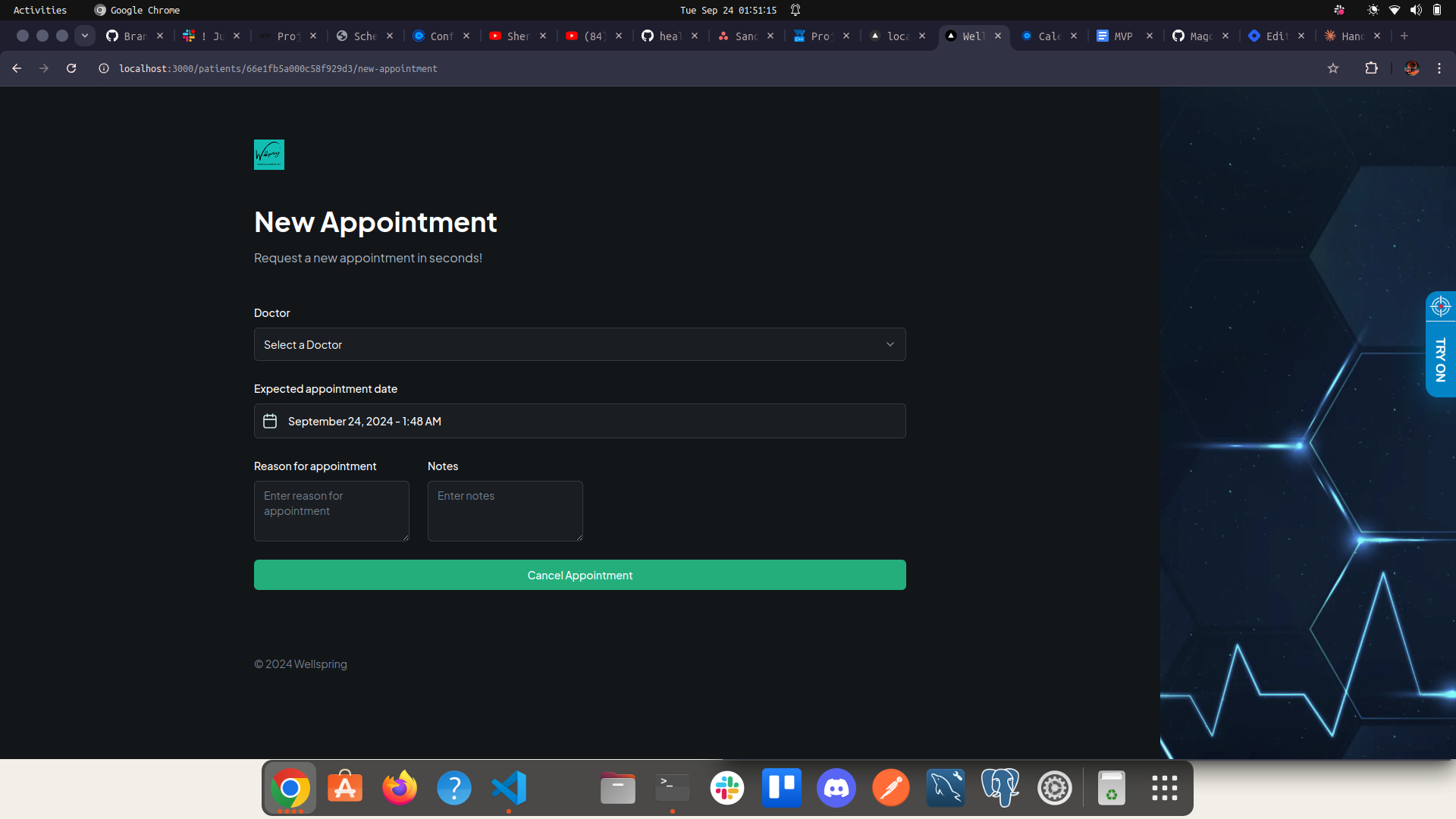Wellspring: Revolutionizing Patient Management in Healthcare
 Ozioma Agaecheta
Ozioma Agaecheta
1. Introduction
Wellspring is a cutting-edge patient management system designed to streamline healthcare operations and improve patient care. Our project aims to revolutionize how healthcare providers manage patient information, appointments, and care coordination.
Our team of developers:
- Ozioma Agaecheta (Full-stack Developer)
We developed Wellspring over 6 weeks, driven by the urgent need for efficient healthcare management systems in the post-pandemic world. Our primary focus was on creating an intuitive, secure, and scalable platform that caters to both large hospital networks and small private practices.
My focus was on implementing robust security measures and ensuring HIPAA compliance throughout the application.
2. A Personal Journey in Healthcare Tech
As a child, I saw people spend countless hours in hospital waiting rooms while my grandmother battled a chronic illness. I vividly remember the frustration on the faces of both patients and staff as they grappled with outdated systems, dust-stricken files, envelopes, and disorganized processes. One particular incident stands out: a mix-up in patient records led to my grandmother almost receiving the wrong medication.
This experience left an indelible mark on me. I realized that inefficient healthcare systems don't just cause inconvenience – they can be a matter of life and death. It fueled my passion for technology and its potential to transform healthcare. Years later, as I embarked on my journey as a software engineer, I knew I wanted to create solutions that could prevent such incidents and improve patient care.
Wellspring is the culmination of that lifelong mission. It's not just a project for me; it's a tribute to my grandmother and a step towards safer, more efficient healthcare for all.
3. Project Accomplishments
Wellspring represents a significant leap forward in patient management systems. Here's an overview of what we've achieved:
Technology Stack:
Frontend: React.js with Next.js and Typescript for server-side rendering and optimal performance
Backend: Express with Next.js and Typescript for a robust and scalable API
Database: AppwriteDB for flexible and efficient data storage
Authentication: AppwriteAuth for secure user authentication and authorization
Cloud Infrastructure: AWS for reliable and scalable hosting
We chose this stack for its combination of performance, scalability, and developer-friendly ecosystem. React and Next.js allow us to create a responsive and fast user interface, while Node.js and Express provide a flexible backend that can handle high traffic loads. MongoDB's document-based structure perfectly suits the varied and complex data types in healthcare.
Key Features:
Intelligent Appointment Scheduling: Our AI-powered scheduling system optimizes appointment slots based on patient history, doctor availability, and urgency of care.
Secure Patient Portal: Patients can access their medical records, and upcoming appointments, and communicate with their healthcare providers through a user-friendly and highly secure portal.
Integrated Telemedicine: Seamless video consultation capabilities are built directly into the platform, allowing for remote patient care when necessary.
Intelligent Appointment Scheduling and Booking: The Intelligent Appointment Scheduling and Booking feature is a cornerstone of the Wellspring patient management system. It's designed to streamline the process of scheduling medical appointments, optimizing both patient convenience and healthcare provider efficiency.
User Experience
For Patients:
Easy Access: Patients can schedule appointments through a user-friendly web interface or mobile app.
Availability View: Patients see a calendar view of available time slots for their preferred healthcare provider.
Smart Suggestions: The system suggests optimal appointment times based on the patient's history, the urgency of care needed, and provider availability.
Quick Booking: With just a few clicks, patients can select a time slot and confirm their appointment.
Reminders: Automated reminders are sent via email and/or SMS to reduce no-shows.
Rescheduling: Patients can easily reschedule or cancel appointments if needed, with the system automatically adjusting wait lists and provider schedules.
For Healthcare Providers:
Dynamic Scheduling: Providers can set their availability, which automatically updates in real-time for patients.
Patient Information: When viewing scheduled appointments, providers can access relevant patient information to prepare for the visit.
Workload Balance: The system helps balance the provider's workload by distributing appointments evenly throughout the day.
Emergency Slots: Providers can reserve slots for urgent or emergency appointments.
Analytics: Providers can view analytics on their schedule efficiency, patient wait times, and other relevant metrics.
4. Overcoming Technical Challenges
The most significant technical hurdle we faced was ensuring rock-solid security while maintaining system performance. Healthcare data is extremely sensitive, and any breach could have catastrophic consequences for patients and providers alike.
Our initial implementation used a traditional role-based access control (RBAC) system. However, as we started integrating more complex scenarios (like temporary access for consulting specialists or emergencies), we realized this approach was too rigid.
We decided to implement a more flexible Attribute-Based Access Control (ABAC) system. This would allow for more granular and context-aware access decisions. However, ABAC systems are notoriously complex to implement and can significantly impact performance if not optimized.
I spent two weeks researching various ABAC implementations and eventually decided to build a custom solution tailored to our specific needs. I created a decision engine that uses a combination of user attributes, resource attributes, and environmental conditions to make access decisions.
The challenge was to make these decisions quickly without causing noticeable delays in the application. I implemented a caching layer that stored frequently accessed policies and pre-computed decisions for common scenarios. This reduced our average decision time from 650ms to under 50ms.
To validate the security of our implementation, we engaged a third-party security firm to conduct penetration testing. They identified a few minor vulnerabilities, which we promptly addressed. The final result was a system that not only met but exceeded industry security standards without compromising on performance.
This experience taught me the importance of thinking beyond conventional solutions and the value of performance optimization in security implementations. It also reinforced my belief in the power of custom solutions when off-the-shelf options fall short.
5. Lessons Learned
Developing Wellspring has been an incredible learning experience:
The importance of domain knowledge: I realized that a deep understanding of the healthcare industry is crucial to building truly effective healthcare software. I've since started taking online courses in healthcare informatics to bridge this knowledge gap.
The power of user-centered design and engineering: Our close collaboration with healthcare professionals throughout the development process led to numerous insights that significantly improved the usability of our system.
The complexity of compliance: Navigating HIPAA and other healthcare regulations was more challenging than I initially anticipated. It's not just about secure coding practices, but also about implementing the right processes and documentation.
The value of scalability from day one: Although we started focusing on small to medium-sized practices, designing for scalability from the beginning allowed us to quickly adapt when larger hospital networks showed interest in our system.
The importance of continuous learning: The healthcare technology landscape is constantly evolving. Staying updated with the latest trends and technologies is crucial for building relevant and impactful solutions.
This project has solidified my passion for healthtech. Moving forward, I plan to specialize further in this domain, possibly pursuing a certification in healthcare IT. I believe there's still so much potential for technology to improve patient outcomes and healthcare efficiency, and I'm excited to be part of this transformation.
6. About the Author
I'm Ozioma Agaecheta and my pen name is Magdiel Amor, a full-stack developer with a passion for creating technology that makes a difference in people's lives. With a background in Economics and computer science and a personal mission to improve healthcare through technology, I strive to build solutions that are not just technically sound but also deeply impactful.
LinkedIn: linkedin.com/in/ozioma-agaecheta
GitHub: github.com/Magdielian-code
Join us in our mission to revolutionize patient care with Wellspring!
Subscribe to my newsletter
Read articles from Ozioma Agaecheta directly inside your inbox. Subscribe to the newsletter, and don't miss out.
Written by
